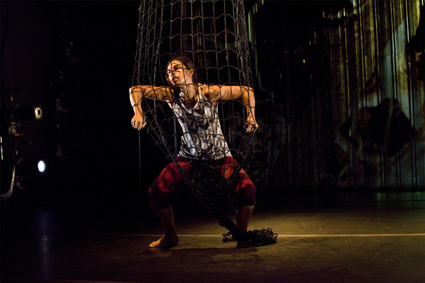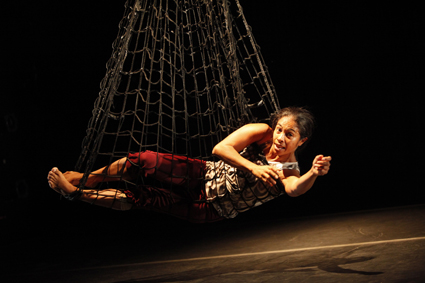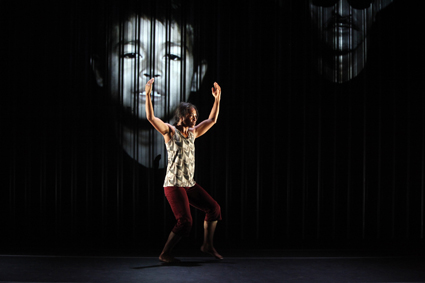dance massive 2013
March 27 2013
dance: installed, immersed, hybridised
keith gallasch: dance massive 2013
quotidian moves, gangnam-style
philipa rothfield: ben speth, wetubelive
dance massive 2013
sounds to dance to, with, against
gail priest: sound design in dance massive 2013
March 26 2013
the life in the work
philipa rothfield: tracie mitchell, dance screen retrospective
youtubing live
varia karipoff: ben speth, wetubelive
dance massive 2013
March 24 2013
dance & disorientation
keith gallasch: tim darbyshire, more or less concrete
more or less monstrous
jana perkovic: atlanta eke, monster body
realtime tv: tim darbyshire, more of less concrete, dance massive 2013
March 22 2013
ritual entwining
philipa rothfield: soo yeun you, [gu:t] [work-in-progress]
strange affliction: dance massive & transcendence
keith gallasch: jo lloyd, future perfect
March 21 2013
a not so private hearing
carl nilsson-polias: tim darbyshire, more or less concrete
realtime tv: antony hamilton, black projects 1& 2, dance massive 2013
something ends, something begins
virginia baxter: dance exchange, dance for the time being - southern exposure
dance massive 2013
the perfection of submission
varia karipoff: jo lloyd, future perfect
March 20 2013
inner fury, seductive skill
philipa rothfield: anouk van dijk, chunky move, 247 days
March 20 2013
old tropes & the new disconnect
carl nilsson-polias: lucy guerin inc & belvoir, conversation piece
March 19 2013
now, then, now
keith gallasch: sandra parker, the recording
realtime tv: anouk van dijk, 247 days, chunky move, dance massive 2013
dance massive 2013
March 18 2013
creating an affective community
jana perkovic: matthew day, intermission
fun and the damage done
keith gallasch: larissa mcgowan, skeleton
more than smoke and mirrors
virginia baxter: ashley dyer, life support
realtime tv: lee serle, p.o.v., dance massive 2013
March 17 2013
realtime tv: dalisa pigram, gudirr gudirr, dance massive 2013
the body un-mirrored
jana perkovic: anouk van dijk, chunky move, 247 days
the origins of feeling
philipa rothfield: sandra parker, the recording
March 16 2013
realtime tv: stephanie lake, dual, dance massive 2013
dance massive 2013
March 15 2013
a dance for dark times
virginia baxter: dalisa pigram, gudirr gudirr
brittle bones & internal electricity
carl nilsson-polias: larissa mcgowan, skeleton
in the thick of it
philipa rothfield: lee serle, p.o.v.
March 15 2013
inside the audience
jana perkovic: lee serle, p.o.v
the poetry of pain
keith gallasch: stephanie lake, dual
dance massive 2013
when two become one
varia karipoff: stephanie lake, dual
March 14 2013
blacker than black
keith gallasch: antony hamilton, black projects 1 & 2
life in a puff
carl nilsson-polias: ashley dyer, life support
March 13 2013
dark symmetries
carl nilsson-polias: antony hamilton, black projects 1 & 2
lines of flight
philipa rothfield: dalisa pigram, gudirr gudirr
dance massive 2013
suggestive formalism
jana perkovic: natalie abbott, physical fractals
unsettling the audience
varia karipoff: natalie abbott, physical fractals
February 22 2013
an intense manifestation of dance
philipa rothfield: dance massive 2013, melbourne
dance massive 2013: from the archive
lucy guerin inc, conversation piece; antony hamilton, black project; atlanta eke, this monster body; matthew day, intermission; jo lloyd, future perfect; tim darbyshire, more or less concrete; natalie abbot, physical fractals; ben speth, wetubelive
 |
Dalisa Pigram, Gudirr Gudirr, Marrugeku
photo Ponch Hawkes |
WHEN DALISA PIGRAM TAKES A WELL-EARNED BOW AT THE END OF GUDIRR GUDIRR, INVITING A LINE OF COLLABORATORS TO JOIN HER, WE ARE SUDDENLY AWARE OF HER DIMINUTIVE STATURE.
For a solo, this is one BIG performance. Accompanied by video projected onto a corrugated iron wall upstage and a long fishing net suspended from the ceiling, Pigram otherwise fills the space for 60 minutes with her intense presence. Gudirr Gudirr (the words call a warning) is a powerful commentary on life in multi-racial Australia told through the experience of this dancer who has a Malay father and Aboriginal mother and lives and works in the country’s north-west. From time to time, the video reminds us of the locale with at once calming and unsettling images of the place and its people.
In a projection of the text, we’re reminded once more of Australia’s racist history. In 1928 an official informs A. O. Neville, Chief Protector of Aboriginals in Western Australia (1875-1954) that quarter-caste Indigenous people (“quadroons”) will be “useful in replacing Aboriginals” as labour for the industries of the north. For this reason, Broome is exempted from the odious White Australia Policy. Pigram appears in fighting stance then moves on to describe in a mix of Yawuru language, Aboriginal English and vivid gesture a joyous experience of fishing with her family that turns dangerous as they overfill their net and are threatened by a crocodile. Harvesting only what’s needed is just one of the survival lessons learned.
From exuberant recreation, Pigram shifts deftly through a parodic airline steward sequence to a series of multi-faceted choreographies variously expressing frustration, resistance, despair, forbearance and celebration. Contained within a strong and compact body her dance mixes Malaysian martial manoeuvres (Silat)—anchored by a low centre of gravity with extended leg and expressive arms—with stances we have come to know from Indigenous dance—solidly grounded feet, torso and hips suddenly and sharply changing plane and aspect, references to animal movement. Moving easily between these forms—a martial stance is enlivened with a quick, animal flick of the wrist—Pigram displays a light-footed grace and a sharp-eyed focus that holds us keenly on her wavelength.
 |
Dalisa Pigram, Gudirr Gudirr, Marrugeku
photo Ponch Hawkes |
At other times she is all muscle and strength deploying the acrobatic skills that are part of Marrugeku’s house style. The suspended net is used to map the space in myriad ways. At one point Pigram deploys it as tissu apparatus, hooking her feet into its threads, executing a series of difficult staccato moves through the fabric to end hanging upside down like the day’s haul. Though we’ve seen it so often, we still catch our breath as she falls, relaxing as she playfully swings from the net, sizing us up.
In the program notes, Pigram describes the generation of these shifting gestures and personas as resulting in part from the ‘task-based process’ she embarked on with director and co-choreographer Koen Augustijnen—a regular collaborator on Marrugeku projects who has also worked with Alain Platel’s Les ballets c de la b—and which together they named “The Tide is Turning.” Says Pigram: “I explore the point in my memory where it felt like my community was changing. I interpret this time through a range of ‘movement channels’ inspired by different characters. Following the task to ‘change the channels,’ I am introducing myself, and others from my community, from the inside out. The audience may see what’s inside of me. They may see the issues that I have that exist as inspirations and concerns through the movement of these characters until they are left with just a person before them, with a story.”
 |
Dalisa Pigram, Gudirr Gudirr, Marrugeku
photo Ponch Hawkes |
Disoriented movement matches angry verbiage as Pigram proselytises from the stage about the pressing need for action on Indigenous issues and follows up with a funny and expletive filled outburst, complete with waving arms, head-banging and huge projected FUCKEN text!, in sheer frustration at the time it’s taking for justice and fairness to prevail. Mood shifts again as we witness video of young Indigenous boys fighting one another—images they display proudly on Facebook. Pigram is still, facing us directly, silently wringing her hands, and then slapping her own face. In one month alone in 2010, seven young people in Pigram’s community killed themselves, the youngest 13 years old.
The work concludes with projected portraits of relatives and friends who form an important part of Pigram’s community, women and children, elders including a white haired man we’ve seen earlier dancing slowly on the screen, and finally the familiar bearded countenance of cultural advisor on this and other Marrugeku projects, Patrick Dodson. Stephen Pigram’s song provides soothing accompaniment as Dalisa Pigram repeats a sequence of calming hand gestures seen earlier on screen.
Gudirr Gudirr is a truly timely work that should be seen widely. Showing all the signs of careful collaboration from a gifted team it conveys complex experience in the shape of Dalisa Pigram who shows us in the sharply shifting facets of her performance the rich and troubled life of her community and of this country.
Dance Massive, Arts House: Gudirr Gudirr, concept, performer and co-choreographer Dalisa Pigram, director and co-choreographer Koen Augustijnen, set design and video artist, Vernon Ah Kee, video production Sam James, composer & sound designer Sam Serruys, singer and songwriter Stephen Pigram, lighting design Matthew Marshall, concept and cultural advisor Patrick Dodson, dramaturg & creative producer Rachael Swain, executive producer John Baylis. Produced by Stalker Theatre and co-commissioned by the City of Melbourne through Arts House, Theatre Im Pfalzbau, Ludwigshafen (Germany) and Les Théâtres de la Ville de Luxembourg; Marrugeku, Arts House, Meat Market, Melbourne, March 12-16; http://dancemassive.com.au/
RealTime issue #114 April-May 2013 pg. 27
© Virginia Baxter; for permission to reproduce apply to [email protected]
Back to top











 back
back